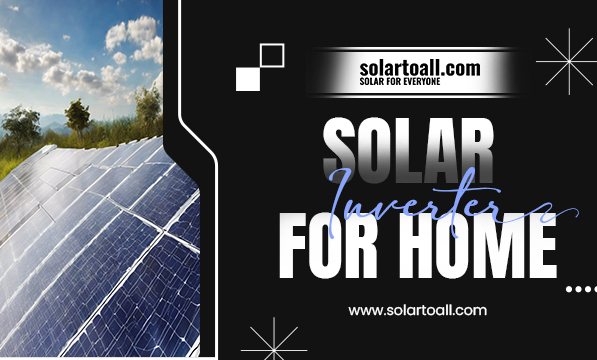
Different types of Solar Inverter for Home - How they reduce your energy bills?
Explore various types of solar inverter for home with Solar To All! Learn how they reduce energy bills and boost efficiency.
SOLAR INVERTER FOR HOME
Solar To All
12/16/20243 min read
Solar energy has revolutionized how homeowners manage their electricity consumption. Solar inverters play a critical role in this system, converting the direct current (DC) produced by solar panels into alternating current (AC) that powers household appliances. By integrating solar inverter for home, homeowners can enjoy reduced energy costs, environmental benefits, and greater energy independence.
Types of Solar Inverters:
1- On-Grid Inverters:
Pros:
Cost-effective as they don’t require batteries.
Access to grid electricity ensures no interruptions.
Cons:
No backup power during outages.
2- Off-Grid Inverters:
Pros:
Total energy independence.
Eliminates electricity bills.
Cons:
High initial cost due to battery storage requirements.
Limited capacity for energy storage.
3- Hybrid Inverters:
Pros:
Backup power during outages.
Flexible and adaptable for future energy needs.
Cons:
Higher initial cost compared to on-grid systems.
Types of On-Grid Solar Inverters:
1. String Inverters:
String inverters connect multiple solar panels in series, forming a "string." They convert the DC power generated by the entire string into AC power.
Pros:
Cost-effective.
Simple installation.
Cons:
Less efficient in shaded or partially shaded conditions.
A single panel failure can impact the performance of the entire string.
2. Microinverters:
Each solar panel has its own microinverter, converting DC power to AC power individually.
Pros:
High efficiency, even in shaded conditions.
Easy monitoring of individual panel performance.
Modular design, allowing for easier system expansion.
Cons:
Higher initial cost compared to string inverters.
3. Power Optimizers:
Similar to microinverters, power optimizers are connected to each solar panel. However, they optimize the performance of each panel, maximizing energy output, especially in shaded conditions.
Pros:
Improved performance in shaded conditions.
Cost-effective compared to microinverters.
Cons:
Less efficient than microinverters.


How Solar Inverters Reduce Energy Bills?
Regardless of the type, solar inverters contribute to energy bill reduction in the following ways:
Environmental Benefits:
Reduced Carbon Footprint: By installing a solar inverter system, you tap into a renewable energy source, drastically reducing your reliance on carbon-heavy power plants.
Energy Independence: Solar inverters empower homeowners to generate electricity on-site, reducing dependence on centralized power grids.
Economic Advantages:
Long-Term Savings: The primary appeal of solar inverters lies in their ability to reduce electricity bills. Once installed, a solar inverter for home can generate most or all of your energy needs, significantly cutting utility costs.
Increased Property Value: Homes equipped with solar inverter systems often have higher resale values. Buyers recognize the financial benefits of lower energy costs and are willing to pay a premium for properties with solar installations.
Net Metering: Many utilities offer net metering programs, allowing you to sell excess solar power back to the grid, further reducing your energy costs.
Practical Benefits:
Reliable Power Supply: Solar inverters, when paired with batteries, provide a consistent power supply even during outages.
Reduced Grid Reliance: Solar inverters reduce dependency on the traditional grid by allowing homeowners to generate, consume, and store their electricity.
Generating Your Own Power: By converting solar energy into usable AC power, you can significantly reduce your reliance on the traditional power grid.
Key Considerations:
Initial Cost: While the upfront cost of installing an On-grid/off-grid/hybrid inverter may seem high, government incentives, tax rebates, and financing options often offset these expenses.
Maintenance: Solar inverters based on your Solar design recommendations and their associated systems require minimal maintenance. Occasional cleaning of solar panels and routine checks for the inverter ensure optimal performance.
Local Regulations: Before installing a solar system, check local regulations and permit requirements.
The best type of inverter for your home depends on various factors, including your budget, roof orientation, shading conditions, and local electricity rates.
Bottom Line: Choosing the Right Inverter
Selecting the right inverter depends on your energy needs, location, and budget: On-grid systems are ideal for areas with reliable grid connectivity and access to net metering programs. Off-grid systems provide energy independence in areas without grid access. Hybrid systems offer the best of both worlds by providing backup power and maximizing energy efficiency.
Solar inverter for home use offer an innovative and sustainable way to reduce energy bills while contributing to a cleaner environment. At solartoall.com, we provide Solar Design Recommendations to help you to choose the correct inverter. It will also make it easy for you to transition to solar energy by connecting you with trusted solar installers and offering tailored solutions for your energy needs.
Solartoall.com
At Solar to All, a top solar panel company, we provide personalized solar design recommendations based on your electricity bill. Explore the latest solar technologies and connect with reputable local solar companies to make your transition to renewable energy seamless.
Contact details
solartoall.com@gmail.com
00918089018840
© 2025. All rights reserved.
